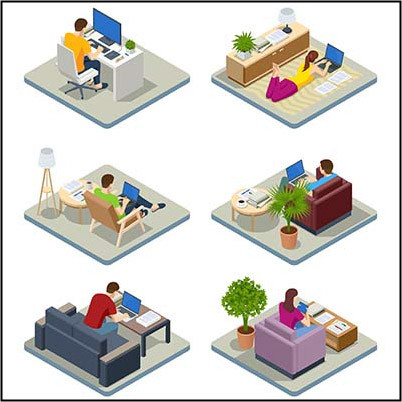The reliance on remote workers has grown exponentially over the past couple of years, and presents businesses some stark challenges as well as some amazing opportunities. As a result, a lot of businesses have tried to find middle ground and started implementing a hybrid approach to their workforce. Let’s take a look at what hybrid work entails and how it can benefit your organization.
Network Synergy Blog
Today, there is a greater focus on mental health and wellbeing than ever before, especially in the shadow of the pandemic. Do you want to improve your employees’ relationships with their colleagues, family, and other important people in their lives? The key to doing so might be remote work, according to a new survey.
Workforces have been increasingly distributed and many businesses aim to continue that strategy for the foreseeable future. There are a fair share of challenges that distributed employees have themselves, but for the business, it can be tough getting them to do the things that need to be done to secure the business. Here are a few actions that need to be taken if you want to make that happen.
We’re coming up on two years since the COVID-19 pandemic changed many workplaces’ operational strategies from in-person work to remote work. In that time, many businesses who hadn’t initially considered remote working to be a viable option have now made it a core part of their onboarding process. This means there are plenty of workers who are now beginning remote work who haven’t really experienced it before. Today, we thought we’d go through a couple of strategies that will help remote employees be as productive as possible as they work from home.
The COVID-19 pandemic is still in full swing, and while many companies buckled under the pressure put on them to maintain operations, others have managed to adapt through the use of remote technology solutions. Businesses have put into place policies surrounding this remote technology, many of which are both helpful and harmful.
Have your opinions of remote work changed at all over the past year and a half, or do you still want your employees to return to the office in full force? Many major companies, despite initially advocating for remote work, are sending mixed signals on the topic, including Microsoft. What can we learn from the experiences of these companies?
The COVID-19 pandemic forced much of the workforce to work remotely, but now that the pandemic is receding in several parts of the world, the question of if this workforce will continue to work remotely is up for debate. A report from Gartner suggests that things will move in the opposite direction from what you might expect. Let’s dive into what this report suggests and what it might mean for your business moving forward.
With countless threats out there waiting for IT professionals to slip up, it’s no small wonder that many of these professionals are opting into what is called a zero-trust policy for their security standards. But what is a zero-trust policy, and why is it so effective at curbing potentially dangerous situations for your business? Let’s investigate this in today’s blog article.
The COVID-19 pandemic forced much of the workforce to work remotely, but now that the pandemic is marginally receding in several parts of the world, the question of if this workforce will continue to work remotely is up for debate. A report from Gartner suggests that things will move in the opposite direction from what you might expect. Let’s dive into what this report suggests and what it might mean for your business moving forward.
The COVID-19 pandemic brought with it no small amount of uncertainty, including amongst business owners who were looking at a very up-in-the-air future. With so many lacking the technology needed to support remote operations—never mind the fact that remote work was a new concept for so many—the learning curve was a considerable hurdle. However, with vaccines being administered and restrictions lifted, it now becomes critical to find a balance.
Now that the school year has begun many young children are juggling between altered classroom setups and continued remote education. Naturally, this has caused a lot of people no small amount of stress. To try and relieve this stress and make the process of working or learning from home as effective as possible, we wanted to share a few tips with you.
Before 2020, remote work was already growing, albeit much more slowly than we see this year (for obvious reasons), but now that just as many workers are working from home (or have the option to work remotely) as are working in the office, we’re beginning to see that it is a functional business model. With many remote workers fairly new to it, we thought we’d see what gadgets members of the Gig Economy are using.
While it seems that some business will best be conducted remotely for some time yet, it is still very important to start planning for a return to in-house operations now. This will help them to hit the ground running when the floodgates open back up. For this week’s tip, we’re going over how to return to the office after working remotely, while also reviewing some best practices for adjusting to remote work (just in case).
The Internet has never been more valuable than it is today. Over the past couple of months tens of millions of students have been introduced to telelearning, millions of businesses have promoted telework, people are meeting with their friends online, and consuming content from their living rooms (or their home offices) at rates never before seen. So what about security? Today we’ll take a look at how all this use is changing the Internet.
Skipping the commute, wearing comfortable pants, and foregoing everyday office distractions has become the new norm during the COVID-19 pandemic, but it’s very likely that the businesses that do well with a remote workforce might continue to keep operating that way even after we’re all able to see each other again.
Many businesses are currently finding the best course of action for them to take right now for the good of their employees is to adopt remote work policies. However, this puts a lot of responsibility on the employees to conduct themselves appropriately and spend the time they should be working diligently.
People are defined by what they do. The first question they are asked by someone they haven’t seen in some time isn’t about their health or their emotions, it is about what they do for a living. With the COVID-19 outbreak, tens of millions of people are out of work and just as many are working from home. For the business owner, this may not be an ideal situation, but if you are able to keep an open mind, you will find that there is a lot of good that could come from having your workers out of the office. This month, we will discuss the benefits of remote work, the gig economy, and some tools that you can use to ensure that remote workers are keeping up their productivity.






















